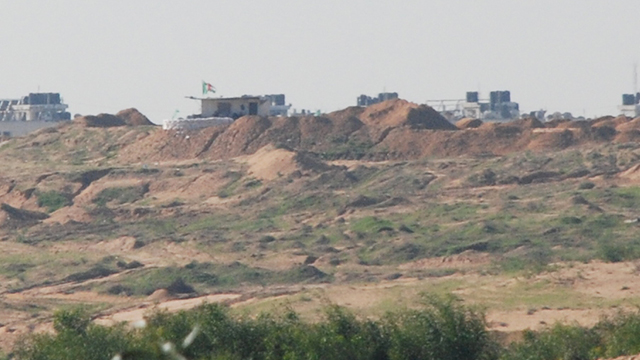
When deterrence deteriorates – shoot fiercely
Analysis: Exchange of fire on Gaza border was not accidental; Hamas prepared for it ahead of time and is using Israel as a lever to create pressure to speed up the reconstruction of Gaza. IDF understands this and is trying to respond firmly. Meanwhile, Hamas' military wing is quickly preparing for next conflict.
The manner in which the exchange of fire took place Wednesday morning along the southern border of the Gaza Strip, along with the way it concluded, illustrates the fact that both sides were prepared for the confrontation that ensued.
Hamas was at the ready with snipers and machine gunners in firing positions, and the IDF was prepared with tanks and air cover for ground troops.
Hamas claims to have opened fire to repel an IDF force that was about to cross over into the Strip, while IDF officials are saying that the troops were in Israeli territory. There may, however, be some truth to the Hamas claim because Israeli soldiers do sometimes operate inside the Strip, in the 300-meter wide buffer zone west of the security fence, in an effort to locate tunnels and neutralize IEDs.
The Palestinians may have believed that the IDF soldiers were about to enter the Strip to carry out such operations. Perhaps the nature of the IDF activities along the fence prompted a demonstration of sovereignty on the part of Hamas.
The IDF's response came quickly, in the form of tank fire and support from aircraft that were already patrolling the skies over the area before the firefight erupted. A local senior Hamas lookout was killed in the exchange. These facts indicate that the IDF was aware of plans by Hamas to carry out a military operation and had prepared for such an event in advance.
Hamas leaders have repeatedly stated of late that they do not want an escalation and wish for things to remain calm so that Gaza's rebuilding can go ahead unhindered. A Hamas military operation, therefore, would be inconsistent with the official stated policy of the organization.
There's a very simple explanation for this: Hamas doesn't want an escalation, but the delays in the Strip's reconstruction and the distress of the population could see the organization come to the conclusion that only by renewing the armed conflict will it be able to extricate itself and the Strip's residents from the current economic and rebuilding stagnation.
Hamas, in fact, is trying to threaten Israel with the renewal of hostilities in an effort to get Jerusalem to pressure Egypt and the Palestinian Authority into working together to rebuild Gaza. Israel itself is actually doing more than anyone else to help the Palestinians, but the rebuilding is moving ahead at a snail's pace.
Meanwhile, Hamas knows that pressure from Israel is the only and most effective leverage at its disposal – not only when it comes to the PA and Egypt, but also with respect to the donor countries, which aren't sending the funds they promised for the rebuilding process and for the salaries of the Hamas government officials.
In October, the donor countries promised a sum of $5.4 billion, but have come up with just $100 million thus far. Hamas also wants Egypt to leave the Rafah Crossing open. The crossing was opened for the first time on Monday because Egyptian President Abdel Fattah el-Sisi wished to appease the Qataris.
The Saudi Arabia-mediated reconciliation between the two states is good news for Hamas. The organization may now be able to receive funds from Qatar, which supports the Muslim Brotherhood through Egyptian banks.
Another reason Hamas is initiating, or not preventing, hostile incidents is because it is responding to shooting incidents carried out by Israel along the border. Recently, the IDF has killed and wounded several Palestinians who tried to scale the fence or stage demonstrations near it.
The Palestinians who tried to cross into Israel were not armed and most were desperate Strip residents hoping to find work in Israel. Some of the demonstrations conducted near the fence were made in an attempt to create pressure for the rehabilitization of Gaza which has been carried out lazily.
The IDF shootings sparked widespread anger in the Strip, and Hamas' military wing appears to be trying to prove that it is protecting the residents of the Strip and won't hesitate to fight fire with fire. At the same time, the military wing is expanding and establishing new strongholds – not only to signal to Israel that it is ready for another confrontation, but also to be able to cope better with such a confrontation.
And finally, Wednesday's incident suggests that the deterrence Israel achieved from Operation Protective Edge is weakening. When it comes to Gaza, deterrence means that Hamas believes that the price it will pay for provoking Israel would be higher than the price it would pay if things remain calm.
Currently, Hamas feels its regime is more at risk due to the distress facing its residents and IDF activities than it would be if the hostilities were to start up again.
Israel, for its part, is trying to bolster the weakened deterrence by illustrating the price Hamas will pay for an escalation. The IDF is attacking and responding to any incident immediately, forcefully and decisively to remind Hamas of the cost of an all-out conflagration.
Meanwhile, Defense Minister Moshe Ya'alon and his aides are working with the Egyptians and other elements to stabilize the ceasefire, and the government's coordinator in the territories is working with PA President Mahmoud Abbas to forward Gaza's rebuilding.
This combination of an immediate and decisive IDF response while assisting in the reconstruction of the Strip is the policy Israel has adopted to prevent an escalation.



















